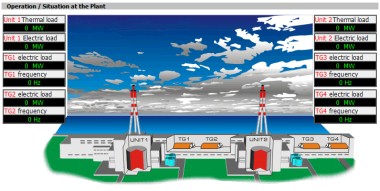With the permanent closure of unit 2 of the Ignalina nuclear power plant on 31 December, Lithuania is no longer a generator of nuclear electricity and will have to rely on imports to meet its electricity demand. However, the country hopes to have replacement nuclear generating capacity in place by 2018.
The shutdown of the two Soviet-designed RBMK reactors at Ignalina was a condition of the accession to the European Union. The EU has agreed to pay decommissioning costs for the two RBMK reactors and some compensation through to 2013. Unit 1 of the Ignalina plant was shut at the end of 2004. The closure of the second Ignalina unit leaves Russia as the only country operating RBMK reactors.
The Ignalina reactors were originally 1500 MWe units (1380 MWe net), but were later de-rated to 1360 MWe (1185 MWe net). Construction started in 1978 and they came on line in 1983 and 1987, with a 30-year design life. Lithuania assumed ownership of them in 1991. They are light-water, graphite-moderated types, similar to those at Chernobyl in Ukraine. A third unit was planned at Ignalina but not completed, and then demolished.
 |
| Real-time data from the plant confirms the idle status of both reactors |
Originally, the Ignalina plants were designed to provide power not only for Lithuania but also for neighbouring Latvia, Belarus and the Kaliningrad area of Russia. In 1989, 42% of the power was exported, but this fell through the 1990s. Following the closure of unit 1, the second unit at Ignalina was supplying over 70% of Lithuania's electricity.
State-owned utility Lietuvos Energija said that the country was prepared for the plant's closure. The company noted that Lithuania had managed to maintain electricity supplies during Ignalina's annual scheduled shutdowns, as well as during unplanned outages at the plant. Lietuvos Energija said that Lithuania's electricity demand in 2010 is expected to be some 9.1 terawatt-hours (TWh), of which more than half would be generated by domestic power plants and the remainder would be imported. Electricity supply contracts have been signed with Estonia, Latvia, Russia, Belarus and Ukraine. There are also possibilities to import electricity from Scandinavia, Lietuvos Energija added.
New nuclear ambitions
In early December, Lithuania officially began its search for strategic investors to construct and operate a new nuclear power plant in the country to replace Ignalina. The government published a notice of public work concession in the Official Journal of the European Union seeking "an experienced investor or investors, which have a long experience in developing new electricity generation capacities and operating nuclear power plants." The deadline for submissions of proposals is 29 January.
Lithuania has proposed building a new nuclear power plant to replace the Soviet-era Ignalina plant, with the participation of neighbouring Poland, Estonia and Latvia. The two-unit plant would be built at Visaginas, near Ignalina, at a cost of around €6.7 billion ($10 billion). The first of the reactors, of up to 1700 MWe each, could come on line in 2018.
The investor would get a majority stake in the proposed new plant, alongside Lithuanian state-owned utility Lietuvos Energija, together with project partners Latvenergo of Latvia, Eesti Energia of Estonia and Poland's Polska Grupa Energetyczna.
The notice said that "the new nuclear power plant project has become a very important goal of the Lithuania government's policy."
Researched and written
by World Nuclear News





_69614.jpg)

_15447.jpg)




